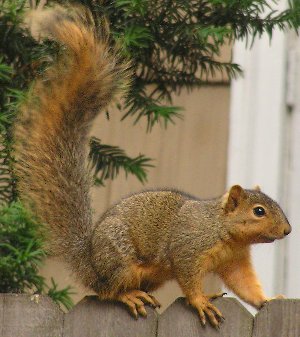I observed the eastern fox squirrel, Sciurus niger, at various locations on the northern end of Rice University campus on February 3, 2014 in the early afternoon starting at 2:20 pm. On this day the skies were grey but not cloudy and the temperature was 46 degrees Fahrenheit. The wind was not that strong, but still very few squirrels were out. The squirrel habitats I observed were the woody and grassy areas of campus in front of the Lovett Hall building along Main Street. I observed squirrels in areas near human traffic such as university bus stops and in areas more isolated from human contact. During observation, I was initially at least 10 feet away from the squirrel subject at all times. However, there were instances when the squirrels traveled towards me in my direction.
I was most intrigued by a pair of squirrels in a grassy area by the bus stop that were both initially digging into the dirt and grass. The two squirrels were in their separate patches about eight feet apart and they were using their forepaws to remove the dirt from the ground. The digging action was very rapid and vigorous, as I could hear them scraping the grass and dirt away. Sometimes, the squirrels would stop digging and move a few inches and dig another hole. At other times, the squirrels would stop and put something into their mouths and start chewing. I assumed these objects to be cached food; however, I could not determine what type of food it was from the distance I was standing. The reason I believe the objects to be cached food is because the squirrels were digging in the grass for it, where no other types of plants besides the grass were growing. If the squirrels were eating grass roots, then I believe they would not have had to dig several holes in their respective grassy patches to search for the roots. Therefore, I believe they were foraging on previously stored foods. I saw this same digging/searching and eating behavior in two more squirrels that I observed that day.
What would cause the squirrel to store food? The use of caches “can be thought of as analogous to body fat, stored up in times of plenty and used in times of scarcity.” (Davies, Krebs, and Stuart 2012). In this way, fox squirrels can store extra energy when food sources are readily available which lets them exceed their digestive capacity restraint. The caches are then used up in times when it is more difficult to find food sources such as the cold weather conditions on this day in early February.
There was initially a confusion about whether fox squirrels actually foraged from caches in the wild. Initial observations by Audubon and Bachman stated that wild fox squirrels do not make caches for the winter but further studies suggested that captive members of this species would store caches of peanuts and other foods during times of surplus to eat later (Moore, 1957). The common consensus now is that they do store and forage from caches and there are studies done on the decisions that a fox squirrel makes in this process (Kotler et al., 1999). One particular study showed that the storability and future value of a food influenced if the animal would forage from it or not (Kotler et al., 1999). Therefore, it is now accepted that both wild and captive squirrels will store caches and forage from them. Since the population of fox squirrels on Rice University campus may not be in a completely “wild” environment it is good to know that both wild and captive squirrels exhibit this behavior.
It is thought that fox squirrels forage from caches mainly to obtain food in times of scarcity which suggests that there may also be an evolutionary basis for this behavior. I could not find any papers about studies investigating caching as a result of a particular genotype, but the following explanation could explain that a genetic basis for this behavior is plausible. Since this caching behavior allows fox squirrels to obtain food when it would otherwise be scarce and improbable to find, it helps fox squirrels to survive. If the fox squirrel is able to survive until times with less harsh conditions, it will have a greater chance of living long enough to reproduce and pass down its genes. Additionally, the extra energy provided from caching would allow the squirrels to spend less time foraging and more time on other activities such as mating to pass down its genes. The squirrels that did not have the genes that express for caching behavior will have to search for scarce food during harsh winter conditions. These squirrels will have less chance to survive and less time and energy to mate and pass on their genes to the next generation. Over many generations, members of the fox squirrel population would have very high frequencies of alleles that express the caching behavior, because members with the caching alleles survived to reproduce more. Since all current fox squirrels are believed to forage from their caches, evolution with this gene may be one cause for the presence of this behavior. But further studies are needed to confirm that this behavior is not a temporary change in behavior to accommodate their environments but rather an adaptation directly related to genotype.
Works Cited
Davies, N. B., Krebs J.R., and West, S.A. (2012) An Introduction to Behavioural Ecology. Oxford: Wiley-Blackwell.
Kotler, B.P, Brown, J.S. and Hickey, M. (1999) Food storability and the foraging behavior of fox squirrels (Sciurus niger). American Midland Naturalist, 142: 77-86.
Moore, Joseph Curtis. (1957) The natural history of the fox squirrel, Sciurus niger shermani. Bulletin of the American Museum of Natural History, 113: 1-72.


